The Ford Escape has been around for 20 years – and while a lot has changed during those years, a lot has stayed the same, too.
The difference – and commonalities – are an interesting commentary on the changes in the car business, generally.
What It Is
The Escape is a compact-sized crossover SUV – just as it was back in 2000, when the first Escape made its debut. It still seats up to five people in two rows, comes in both front-drive and all-wheel-drive iterations and offers your pick of three different drivetrains – the same as it did 20 years ago.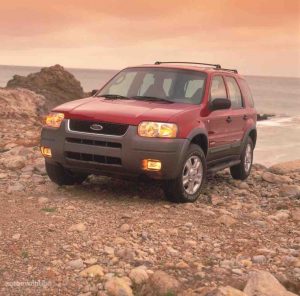
But the drivetrains are very different today – and the new Escape offers features that you only saw in the sci-fi series like Star Trek: The Next Generation back in 2000.
Like a flat screen instrument panel array. And holographic information displays.
Prices start at $24,885 for the front-wheel-drive S trim, which comes standard with a 1.5 liter three cylinder engine.
If you want all-wheel-drive, it’s available for $26,385. 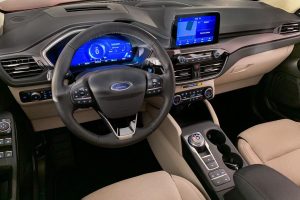
If you want more power, the Escape is available with a turbocharged 2.0 liter four cylinder engine that’s much stronger than the original Escape’s optional V6 engine. It’s paired with AWD that can be disconnected when not needed – which the original Escape’s AWD system couldn’t be.
It stickers for $33,040
And if you want something really different, there’s a hybrid version – also with (or without) all-wheel-drive. This one delivers three times the mileage the old Escape did. It can also go three times as far as the old V6 Escape could – if you can select a plug-in option that gives you almost 600 miles of highway range on a full tank (and a full charge).
Without having to stop to recharge.
A top-of-the-line AWD-equipped Titanium trim with the plug-in hybrid drivetrain stickers for $34,900.
What’s New
The 2020 Escape is a wheels-up redesign; the wheels are new, too.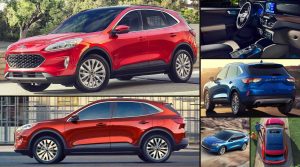
What’s Good
Unlike many in this class – which offer a standard and optional engine – the Escape is available with three different engines – and two different transmissions.
Sliding second row opens up more legroom – and cargo room.
Hybrid offers diesel-like range without the electric car wait.
What’s Not So Good
Hybrid’s high cost argues against its mileage benefit.
A manual transmission isn’t available.
A diesel engine isn’t available.
It’s pretty wild to find a three cylinder engine under the hood of a car – and even more so under the hood of an SUV. The 2020 Escape’s 1.5 liter engine is smaller than some motorcycle engines. But it produces 180 horsepower – which is 50 more horsepower than the original Escape’s 2.0 liter four cylinder managed.
The next-up engine is also a 2.0 liter engine. It makes 50 more horsepower than the original Escape’s available 3.0 liter V6 engine managed.
And the optional 2.5 liter gas-hybrid combo makes as much – or more – power than the old V6 (198 or 209, depending on whether you go closed-circuit or plug-in) while going three times as far on a gallon of gas.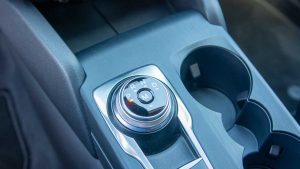
The original Escape’s 3.0 liter V6 – which made 200 hp – drank so much gas (16 city, 22 highway) that it almost needed to pull a tanker behind it. The new Escape hybrid drinks so little (44 city, 37 highway) you might only need to stop for gas a couple of times a month.
It’s just as quick, too. Zero to 60 in 8.6 seconds – same as the 16 MPG original.
And it doesn’t make you wait.
The hybrid layout frees you from having to plan your day around recharging – where to do it and how much time it’ll take. The regular hybrid just drives – like any other car.
When you run low – on gas – you stop (briefly) and fuel up. Back on the road in five minutes or so. The gas engine recharges the battery for the electric side of the hybrid system as you drive.
The plug-in goes both ways. You can just gas and go. Or – when you have time – plug it in and wait for the battery to charge up without using the gas engine as a generator. Then use “EV” mode to drive without burning any gas – or worrying about running out of charge.
You pull up to 3,500 lbs. with an Escape – par for the class. But the maximum tow rating varies according to the drivetrain you select – and in ways you might not expect.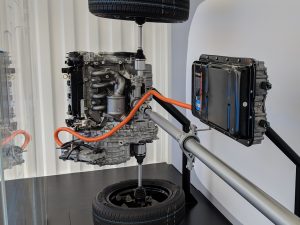
The base Escape with the 1.5 liter engine is rated to pull 2,000 lbs. but the more powerful hybrid can only tug along 1,500 lbs. The lower capacity is due to the fact that the hybrid is already lugging around more weight before you hook anything up to its rear end.
With the 2.0 liter engine, the Escape can handle up to a 3,500 lb. trailer.
No matter which engine you pick, the Escape isn’t slow – unlike the original, which was borderline dangerously slow with its standard 130 hp engine.
Your choice is between quick – and quicker.
The drive also lasts longer because you don’t need to stop as often. The original with the V6 was decently quick but haltingly consumptive. It averaged maybe 14 MPG, which meant its 15 gallon tank could be emptied in as little as 210 miles.
A new Dodge Hellcat goes farther on a tankful.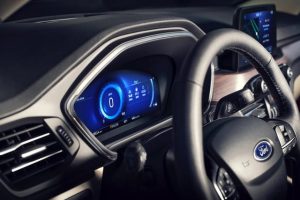
The hybrid goes almost as far as a diesel – which Ford used to offer in the European version of the last-generation Escape (called Kuga in Europe) but never brought to the United States – and never will, because of the anathematization of diesel engines – which are too efficient/affordable/practical and so make electric cars look stupid.
The next best thing is the hybrid, which not only approximates the range of a diesel but also the torque – one of the good things about electric motors. Ford knows that while gas is cheap, gas mileage isn’t the sell it used to be. So while the hybrid Escape is very fuel sippy it is also very peppy. Like a diesel-powered car, it jumps forward when asked to – and without having to rev it.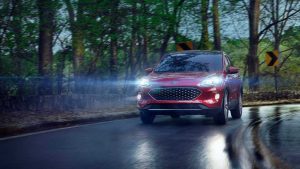
It’s arguably better than a diesel – at least, a modern, government-crippled diesel – because you don’t have to feed the hybrid DEF (diesel exhaust fluid) or deal with purging particulate traps or pay 40 cents extra per gallon for fuel.
Speaking of which – all the Escape’s engines are regular (87 octane) unleaded engines. So you don’t have to pay 20 cents extra per gallon for high-octane premium unleaded.
An interesting – and useful – feature of AWD-equipped Escapes is that they can run with the AWD off when the extra grip of four powered wheels isn’t needed and powering all four wheels would be wasteful.
You save gas – and wear and tear.
Which is also saved by one of the deepest overdrive ratios you’ll find in any new car – .62 in eighth, which lets the Escape sail at highway speeds with the engine almost off.
But the drive is a bit less fun than it was back in the day – because you can’t shift for yourself, no matter which engine you pick. The original Escape was available with a five-speed manual transmission. The 2020 comes standard with an eight-speed automatic – which many people will be happy about because so many crossovers come only with a continuously variable automatic – and many people dislike the “shiftless” operating characteristics of CVTs.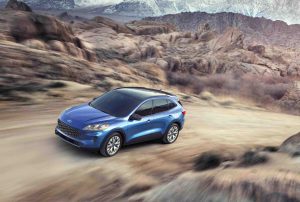
It shifts snappily – and more efficiently – than a human-shifted manual, which is why Ford (and most car makers) rarely offer manuals anymore – in anything.
But there’s something to be said for shifting for yourself, even if it does cost a couple of MPGs.
And if you do prefer a CVT, no worries. The hybrid version has one. And it’s not noisy. Or even very different, in terms of how it feels. The non-hybrid’s eight-speed goes through gears, but the gear changes are subtle and unless you’re watching the tach and noting the RPM changes as the transmission shifts through its gears, you’ll probably have a hard time telling the difference.
The original Escape looked like a truck-based SUV. It was boxy – which had the upside of making it roomy.
Just like an SUV – but without actually being an SUV. The whole point was to give people who wanted or needed more than a car the option to buy a vehicle that still drove (and rode) like a car. . . not like a truck-based SUV.
This is one of the reasons for the popularity of crossovers.
The new Escape isn’t boxy – and it’s roomier. In part because of the flexibility of its fore-aft sliding second row. Pull them forward – and lay them flat – and the Escape has 65.4 cubic feet of cargo room.
Or 40.7 inches of backseat legroom – exceptionally roomy for this class.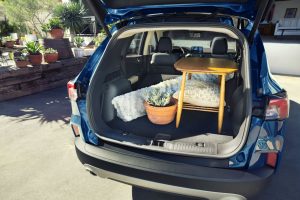
The Escape is after all only 180.5 inches long, bumper to bumper – which is about a foot shorter overall than a current mid-sized sedan such as a Toyota Camry, which is 192.7 inches bumper-to-bumper and only has 38 inches of backseat legroom.
And just 15.2 cubic feet of cargo capacity in its trunk – about a fourth of the capacity for cargo that the Escape offers.
Another reason for the popularity of crossovers – and the declining popularity of mid-sized sedans like the Camry and Accord and the rest of them. Several of them (Chevy Cruze and Malibu, Ford Taurus and Fusion) have been cancelled for lack of popularity.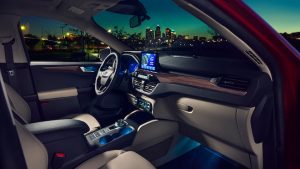
Ford has also added previously Lincoln-only features such as an external keypad entry system and an available 10-speaker Bang and Olufsen ultra-premium audio system. Also futuristic features, such as the available 12.3 inch flat-screen main gauge cluster (hybrid versions come standard with this) and a heads-up display (HUD) which projects pertinent information such as the speed you’re doing holographically, in your line of sight.
It’s pretty remarkable to find features like this in an Escape – which is a very bread-and-butter/middle-of-the-road kind of car.
Back in 2000, the only thing that had a touchscreen was the starship Enterprise – which wasn’t real.
As recently as five or six years ago, the only cars that had them were very expensive real things – like the Mercedes S-Class.
This tech – as well as used-to-be luxuries such as climate control AC, very good audio systems (not merely stereos) are now almost givens in everyday cars like the Escape. This is nice – in that almost everyone can experience things which until quite recently only the very rich could experience. But it also generalizes specialness, which induces a kind of jaded ennui when it comes to new cars.
When every car has things like a configurable touchscreen, what makes this car with a configurable touchscreen special?
I think part of the explanation for the public fascination with EVs is that they’re the first really different thing to come down the line in years – and that this specialness also accounts for the general cognitive dissonance about the EV’s many functional and practical and economic deficits.
The Rest
Given how inexpensive gas is, it’s hard to justify the Escape hybrid’s price . . . if you go solely by MPGs. But when you factor in the range – twice that of any electric car – with the performance and the convenience of not having to stop to recharge, the thing makes a different kind of sense.
There is one downside, however.
Or rather, a weird side. The hybrid isn’t silent anymore. For saaaaaaaaaafety – and because it’s now The Law – a weird noise is emitted by the Escape hybrid (and all 2020 hybrids) whenever you put it in Reverse. So that sail-fawn-addled pedestrians will hear you backing up and not be pizza-pied by the Escape.
It sounds like bad wheel bearings but it’s nothing to worry about. It’s supposed to sound like that.
Probably, there’s a hack somewhere that can be performed to shut this off.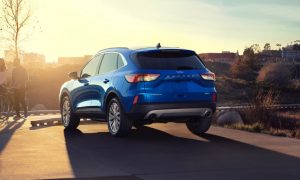
Same goes for ASS – the automated stop/start “technology” which all versions of the Escape unfortunately come standard with. There’s no obvious ASS-off button, either – as seems to be the new trend with ASS-equipped new cars.
Which is almost all new cars.
It’s one thing that’s changed which may of us wish hadn’t.
The Bottom Line
Back in 2000, a crossover was something different. The 2020 Escape still is in some important ways – and the same in other ways, too.
And that’s also a good thing!
…
Got a question about cars, Libertarian politics – or anything else? Click on the “ask Eric” link and send ’em in!
If you like what you’ve found here please consider supporting EPautos.
We depend on you to keep the wheels turning!
Our donate button is here.
If you prefer not to use PayPal, our mailing address is:
EPautos
721 Hummingbird Lane SE
Copper Hill, VA 24079
PS: Get an EPautos magnet or sticker or coaster in return for a $20 or more one-time donation or a $10 or more monthly recurring donation. (Please be sure to tell us you want a magnet or sticker or coaster – and also, provide an address, so we know where to mail the thing!)
My latest eBook is also available for your favorite price – free! Click here. If that fails, email me at EPeters952@yahoo.com and I will send you a copy directly!





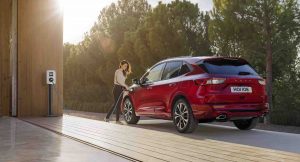
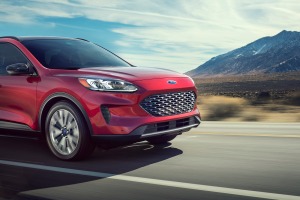

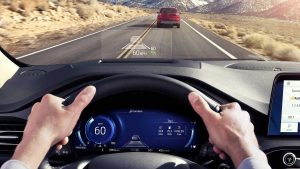







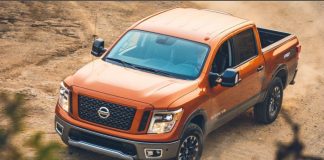
It will be interesting to seed how the Bronco Sport, which is to based on the Escape, will differ. Particularly in the drivetrain.
Will the AWD simply carry over from the Escape? Or will Ford attempt a Jeepish system, as in the Cherokee and Renegade (the likely target of the Bronco Sport)?
WAAAYYY
TOOOO
EXPENNNNNSIIIIVVVEEEE
!
This new Ford Escape will make a fine little rental car.
I want to like it, but I can’t get past the blah looks of it. Like the Mercedes GLC and several other new crossovers – it’s got no character to the body.
Mom tried to test-drive an Escape, but the pimply-faced car salesman kept trying to get her in a $55,000 Explorer, even after being told several times it was too big and too expensive. No sale!
I actually sort of liked the early “boxy” Escapes, but this Ford Blob looks like all the other blobs out there.
You’d think they would have learned after the 3rd gen “bubble” Taurus
Hmmm. I swore off the F-word 40 years ago, after two Pintos and an Anglia (and a friend’s Torino that was constantly leaving parts on the road). This might just make me take a second look. The hybrid sounds interesting. This is why I read all of your reviews Eric, sometimes I get my mind changed on a car. Of course, a THREE FRIGGIN CYLINDER in an SUV? Maybe not for me, that’s a bridge too far. But, the 2.0 or the hybrid sound…interesting.
” For saaaaaaaaaafety – and because it’s now The Law – a weird noise is emitted by the Escape hybrid (and all 2020 hybrids) whenever you put it in Reverse.”
Jesus,,, You’re gonna need earmuffs. Can you imagine a whole parking full of them things! Gonna sound like a 40lb Cricket invasion. All this to warn the idiots with Ithingies not smart enough to watch where they’re going?
Man,,, It just gets stupider and stupider!
“powering all four wheels would be wasteful”
I’ve never been able to figure this out … You’re powering all four wheels on every car, all the time you are moving – either through the driveline(s) or through the road surface.
Think of old 4x4s with manual locking hubs. When unlocked the wheels free wheel, and don’t spin the driveline components, along with the resulting friction and losses.
The Escape system, apparently, disconnects the rear wheels from the driveline.
“Apparently” ????
Well, I would have to look at one, but I rather doubt it based on other AWDs. I’m pretty sure it has CV axles splined into the bearing hub with a big nut on the outside just like the front (FWD, AWD, and all new 4WD except Wrangler/Gladiator).
If it DOES have some sort of remote control rear unlocking hubs, then that is just one more damn thing to go wrong – usually when you need it most.
It’s described by Ford as a disconnect. I’ve yet to find a more technical description of how it operates.
Further investigation suggests that this is the same system in the Edge, which is Dana’s Spicer SmartConnect system.
The President of Dana described it in an interview as:
“Recently we launched our latest product called Spicer SmartConnect, which is our disconnecting 4-wheel drive product for crossovers and SUVs. It is essentially an independent axle that can disconnect through the clutch mechanism on both the single and double side.”
Then later, in response to a question:
“Right now that isn’t exactly the way it works. It is a smart connect system using motors and controllers that talk to the vehicle and actuate the clutch mechanism.”
Explained starting at 1:10.
https://youtu.be/ETBVNnd6NGU
Nice animation. Too bad it doesn’t make any sense.
So it’s just another version of disconnecting one half-axle from the differential, similar to the trouble prone system on Chevy pickups (front). It doesn’t disconnect the wheels at the hubs, so both half axles still turn, which means the spider gears are still spinning like crazy – which the animation fails to show!
The spider gears HAVE TO spin on each other because the other axle is still splined into the output gear. I can’t figure out how that is good for any differential? Those little gears aren’t supposed to turn on each other except for when you are going around a turn. That’s why they always tell you to run the same size tire/wheel on both sides. Except with one axle disconnected and the driveshaft stopped, the carrier/ring isn’t even turning to splash oil up on the spider gears.
Funny, the Jeep XJ started out with an axle disconnect but it was such a problem that they discontinued it and just don’t worry about the axle and driveshaft turning all the time. I have no clue how the new Jeeps work, except that Wranglers don’t have front lock out hubs.
The video claims that the gears stop turning. :shrug:
Regarding the current Wranglers, the front driveline just spins in rwd unless aftermarket locking hubs have been installed.
The video can claim whatever it wants but the non-clutched axle is still attached to one of the spider gears, therefore all four spider gears will turn but friction will keep the driveshaft from turning.
On the Wrangler, you have to install a lot more than just locking hubs. You have to replace the spindles and axles, etc. At least the parts are available. There’s a YT video showing it done and they also convert the rear to full floating. I think they ended up with 8 lug wheels all the way around.